A Novel Hybrid Model for Financial Forecasting Based on CEEMDAN-SE and ARIMA-CNN-LSTM
Abstract
1. Introduction
2. Related Work
3. Preliminary Work
3.1. CEEMDAN
- (1)
- Add Gaussian white noise to the original signal a total of times to construct a total of preprocessed sequences:where denotes the Gaussian white noise used in the n-th processing iteration.
- (2)
- Perform EMD decomposition on all the preprocessed sequences to obtain the first IMF component . Then, take the mean of these components and employ it as the first IMF component obtained by CEEMDAN, and obtain the first residual sequence , as shown in Equations (2) and (3).
- (3)
- Similarly, add Gaussian white noise to the residual sequence to construct new sequences . Perform EMD decomposition on these sequences, and calculate their mean to obtain the second IMF component , as shown in Equation (4). And subtract this mean to obtain the updated residual sequence , as shown in Equation (5).
- (4)
- Perform EMD decomposition times on , and thus obtain the + 1th IMF sequence after CEEMDAN decomposition, as shown in Equation (6).
- (5)
- Repeat the above steps until the decomposition stops. The final residual sequence is expressed in Equation (7).
- (6)
- The final expression for the signal sequence after CEEMDAN decomposition is shown in Equation (8).
3.2. Sample Entropy
3.3. LSTM
3.4. CNN
3.5. ARIMA
3.5.1. AR Model
3.5.2. MA Model
3.5.3. Parameter Determination
- (1)
- Determination of p and q
- (2)
- Information criteria law
4. Methodology
- Input the original data and use the CEEMDAN algorithm to obtain the decomposed intrinsic mode functions (IMFs).
- Calculate the sample entropy values of each IMF. Components with similar complexities are integrated into Co-IMF components to reduce non-stationarity and non-linearity.
- For the high-frequency stationary Co-IMF components, use the ARIMA model for prediction. For the low-frequency Co-IMF components containing historical trend dynamic information, use the CNN-LSTM model for prediction.
- Overlap the predicted results of each Co-IMF to obtain the final prediction and conduct error analysis.
5. Experimental Work
5.1. Experimental Environment
5.2. Data Collection and Analysis
5.3. Sample Entropy Complexity Calculation for Each IMF
5.4. Determination of ARIMA for Co-IMF1 and the Prediction Result
- Test the Augmented Dickey–Fuller (ADF) value of the original data and generate Autocorrelation Function (ACF) and Partial Autocorrelation Function (PACF) plots of the original data.
- If the original data are non-stationary, perform differencing operations on the data at time t and t − 1 to achieve stationarity. Then, based on the plots, determine whether further differencing is necessary.
- Determine the order of the model parameters based on the Akaike Information Criterion (AIC) or Bayesian Information Criterion (BIC).
- Establish an ARIMA model using the parameters obtained from step 3 and obtain the results. Diagnose the model by examining the residuals obtained. If the model’s accuracy is low, re-select the model parameters.
5.5. CNN−LSTM Prediction Model for Co−IMF2 and the Prediction Result
5.6. Final Result and Error Evaluation
6. Conclusions
- (1)
- The hybrid model that combines statistical learning and deep learning performs better than the individual models.
- (2)
- For low-frequency components, LSTM is more effective than GRU in capturing long-term historical dynamics.
- (3)
- Adding CNN convolutional blocks can better extract the fluctuation characteristics of time series.
Author Contributions
Funding
Data Availability Statement
Conflicts of Interest
References
- Zhou, F.; Zhang, Q.; Sornette, D.; Jiang, L. Cascading logistic regression onto gradient boosted decision trees for forecasting and trading stock indices. Appl. Soft Comput. 2019, 84, 105747. [Google Scholar] [CrossRef]
- Yu, H.; Chen, R.; Zhang, G. A SVM stock selection model within PCA. Procedia Comput. Sci. 2014, 31, 406–412. [Google Scholar] [CrossRef]
- Alfonso, G.; Ramirez, D.R. Neural Networks in Narrow Stock Markets. Symmetry 2020, 12, 1272. [Google Scholar] [CrossRef]
- Heo, W.; Kim, E.; Kwak, E.J.; Grable, J.E. Identifying Hidden Factors Associated with Household Emergency Fund Holdings: A Machine Learning Application. Mathematics 2024, 12, 182. [Google Scholar] [CrossRef]
- Jeong, G.; Kim, H.Y. Improving financial trading decisions using deep Q-learning: Predicting the number of shares, action strategies, and transfer learning. Expert Syst. Appl. 2019, 117, 125–138. [Google Scholar] [CrossRef]
- Nabipour, M.; Nayyeri, P.; Jabani, H.; Mosavi, A.; Salwana, E. Deep learning for stock market prediction. Entropy 2020, 22, 840. [Google Scholar] [CrossRef]
- Huang, N.E.; Shen, Z.; Long, S.R.; Wu, M.C.; Shih, H.H.; Zheng, Q.; Yen, N.C.; Tung, C.C.; Liu, H.H. The empirical mode decomposition and the Hilbert spectrum for nonlinear and non-stationary time series analysis. Proc. R. Soc. Lond. Ser. A Math. Phys. Eng. Sci. 1998, 454, 903–995. [Google Scholar] [CrossRef]
- Wu, Z.; Huang, N.E. Ensemble empirical mode decomposition: A noise-assisted data analysis method. Adv. Adapt. Data Anal. 2009, 1, 1–41. [Google Scholar] [CrossRef]
- Torres, M.E.; Colominas, M.A.; Schlotthauer, G.; Flandrin, P. A complete ensemble empirical mode decomposition with adaptive noise. In Proceedings of the 2011 IEEE International Conference on Acoustics, Speech and Signal Processing (ICASSP), Prague, Czech Republic, 22–27 May 2011; pp. 4144–4147. [Google Scholar]
- Cao, J.; Wang, J. Stock price forecasting model based on modified convolution neural network and financial time series analysis. Int. J. Commun. Syst. 2019, 32, e3987. [Google Scholar] [CrossRef]
- Pang, X.; Zhou, Y.; Wang, P.; Lin, W.; Chang, V. An innovative neural network approach for stock market prediction. J. Supercomput. 2020, 76, 2098–2118. [Google Scholar] [CrossRef]
- Hochreiter, S.; Schmidhuber, J. Long short-term memory. Neural Comput. 1997, 9, 1735–1780. [Google Scholar] [CrossRef]
- Cao, J.; Li, Z.; Li, J. Financial time series forecasting model based on CEEMDAN and LSTM. Phys. A Stat. Mech. Its Appl. 2019, 519, 127–139. [Google Scholar] [CrossRef]
- Fjellström, C. Long short-term memory neural network for financial time series. In Proceedings of the 2022 IEEE International Conference on Big Data (Big Data), Osaka, Japan, 17–20 December 2022; pp. 3496–3504. [Google Scholar]
- Hoseinzade, E.; Haratizadeh, S. CNNpred: CNN-based stock market prediction using a diverse set of variables. Expert Syst. Appl. 2019, 129, 273–285. [Google Scholar] [CrossRef]
- Shi, Z.; Hu, Y.; Mo, G.; Wu, J. Attention-based CNN-LSTM and XGBoost hybrid model for stock prediction. arXiv 2022, arXiv:2204.02623. [Google Scholar]
- Chen, L.; Chi, Y.; Guan, Y.; Fan, J. A hybrid attention-based EMD-LSTM model for financial time series prediction. In Proceedings of the 2019 2nd International Conference on Artificial Intelligence and Big Data (ICAIBD), Chengdu, China, 25–28 May 2019; pp. 113–118. [Google Scholar]
- Yu, L.; Wang, S.; Lai, K.K. Forecasting crude oil price with an EMD-based neural network ensemble learning paradigm. Energy Econ. 2008, 30, 2623–2635. [Google Scholar] [CrossRef]
- Shu, W.; Gao, Q. Forecasting stock price based on frequency components by EMD and neural networks. IEEE Access 2020, 8, 206388–206395. [Google Scholar] [CrossRef]
- Tang, L.; Wu, Y.; Yu, L. A randomized-algorithm-based decomposition-ensemble learning methodology for energy price forecasting. Energy 2018, 157, 526–538. [Google Scholar] [CrossRef]
- Tang, L.; Lv, H.; Yu, L. An EEMD-based multi-scale fuzzy entropy approach for complexity analysis in clean energy markets. Appl. Soft Comput. 2017, 56, 124–133. [Google Scholar] [CrossRef]
- E, J.; Ye, J.; Jin, H. A novel hybrid model on the prediction of time series and its application for the gold price analysis and forecasting. Phys. A Stat. Mech. Its Appl. 2019, 527, 121454. [Google Scholar] [CrossRef]
- Zhou, S.; Lai, K.K.; Yen, J. A dynamic meta-learning rate-based model for gold market forecasting. Expert Syst. Appl. 2012, 39, 6168–6173. [Google Scholar] [CrossRef]
- Liang, Y.; Lin, Y.; Lu, Q. Forecasting gold price using a novel hybrid model with ICEEMDAN and LSTM-CNN-CBAM. Expert Syst. Appl. 2022, 206, 117847. [Google Scholar] [CrossRef]
- Vidal, A.; Kristjanpoller, W. Gold volatility prediction using a CNN-LSTM approach. Expert Syst. Appl. 2020, 157, 113481. [Google Scholar] [CrossRef]
- Lee, Y.H.; Kim, E. Deep Learning-based Delinquent Taxpayer Prediction: A Scientific Administrative Approach. KSII Trans. Internet Inf. Syst. 2024, 18, 30–45. [Google Scholar]
- Yang, Y.; Yang, Y. Hybrid method for short-term time series forecasting based on EEMD. IEEE Access 2020, 8, 61915–61928. [Google Scholar] [CrossRef]
- He, K.; Ji, L.; Wu, C.W.D.; Tso, K.F.G. Using SARIMA–CNN–LSTM approach to forecast daily tourism demand. J. Hosp. Tour. Manag. 2021, 49, 25–33. [Google Scholar] [CrossRef]
- Chung, W.H.; Gu, Y.H.; Yoo, S. District heater load forecasting based on machine learning and parallel CNN-LSTM attention. Energy 2022, 246, 123350. [Google Scholar] [CrossRef]
- Eapen, J.; Bein, D.; Verma, A. Novel deep learning model with CNN and bi-directional LSTM for improved stock market index prediction. In Proceedings of the 2019 IEEE 9th Annual Computing and Communication Workshop and Conference (CCWC), Las Vegas, NV, USA, 7–9 January 2019; pp. 0264–0270. [Google Scholar]
- Livieris, I.E.; Pintelas, E.; Pintelas, P. A CNN–LSTM model for gold price time-series forecasting. Neural Comput. Appl. 2020, 32, 17351–17360. [Google Scholar] [CrossRef]
- Zhang, R.; Yuan, Z.; Shao, X. A new combined CNN-RNN model for sector stock price analysis. In Proceedings of the 2018 IEEE 42nd Annual Computer Software and Applications Conference (COMPSAC), Tokyo, Japan, 23–27 July 2018; Volume 2, pp. 546–551. [Google Scholar]
- Richman, S.; Moorman, R. Physiological time-series analysis using approximate entropy and sample entropy. Am. J. Physiol.-Heart Circ. Physiol. 2000, 278, H2039–H2049. [Google Scholar] [CrossRef]
- Ma, X.; Tao, Z.; Wang, Y.; Yu, H.; Wang, Y. Long short-term memory neural network for traffic speed prediction using remote microwave sensor data. Transp. Res. Part C Emerg. Technol. 2015, 54, 187–197. [Google Scholar] [CrossRef]
- Graves, A.; Graves, A. Long short-term memory. In Supervised Sequence Labelling with Recurrent Neural Networks; Springer: Berlin/Heidelberg, Germany, 2012; pp. 37–45. [Google Scholar]
- Greff, K.; Srivastava, R.K.; Koutník, J.; Steunebrink, B.R.; Schmidhuber, J. LSTM: A search space odyssey. IEEE Trans. Neural Netw. Learn. Syst. 2016, 28, 2222–2232. [Google Scholar] [CrossRef]
- Lecun, Y.; Bottou, L.; Bengio, Y.; Haffner, P. Gradient-based learning applied to document recognition. Proc. IEEE 1998, 86, 2278–2324. [Google Scholar] [CrossRef]
- Valipour, M.; Banihabib, M.E.; Behbahani, S.M.R. Comparison of the ARMA, ARIMA, and the autoregressive artificial neural network models in forecasting the monthly inflow of Dez dam reservoir. J. Hydrol. 2013, 476, 433–441. [Google Scholar] [CrossRef]
- Ma, Y.; Yang, B.; Su, Y. Technical trading index, return predictability and idiosyncratic volatility. Int. Rev. Econ. Financ. 2020, 69, 879–900. [Google Scholar] [CrossRef]
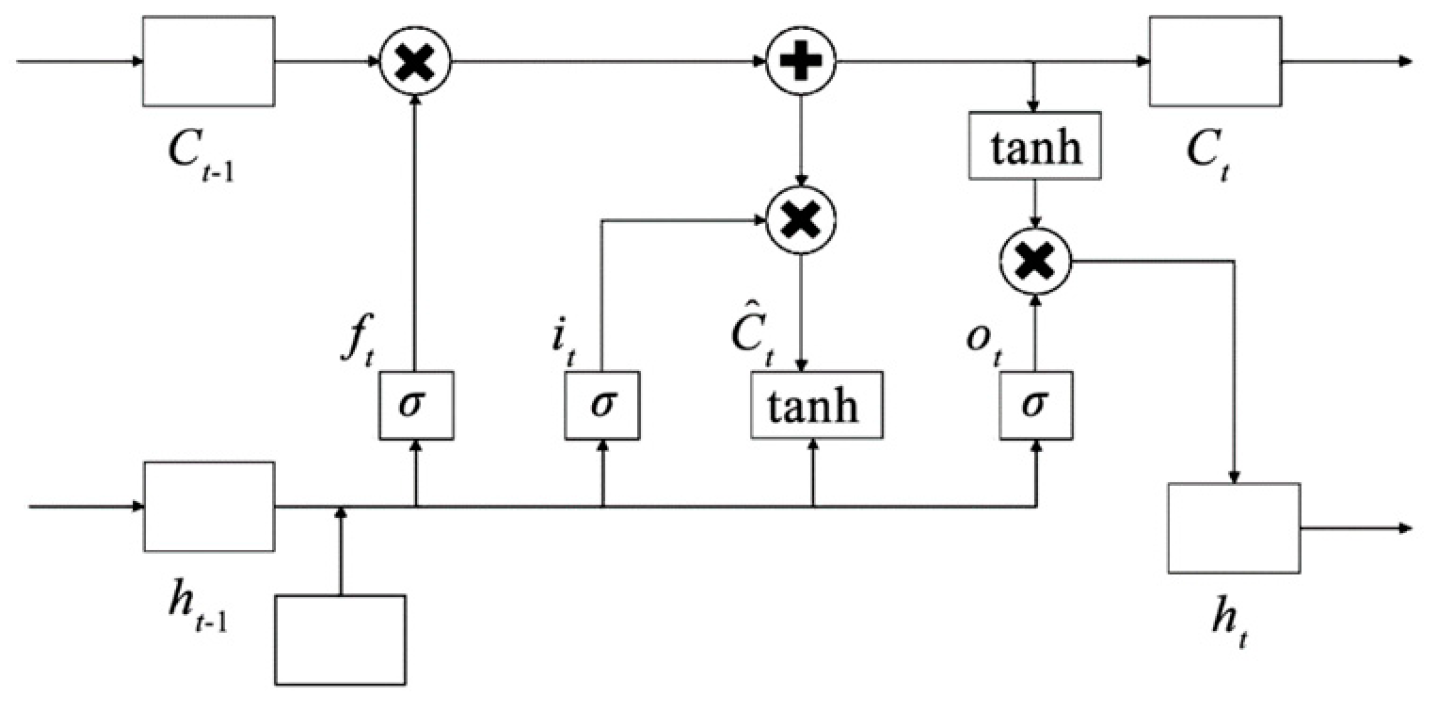



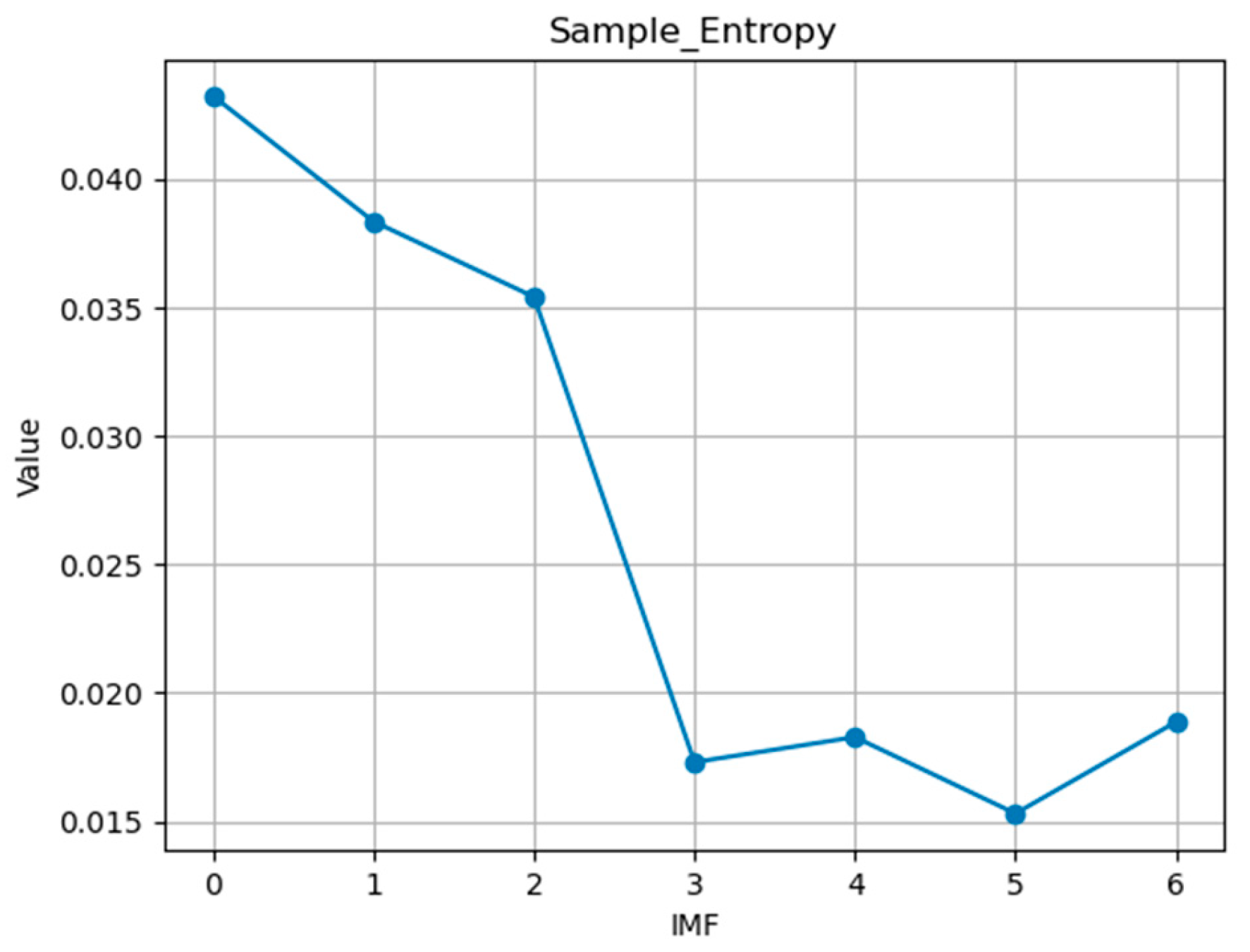
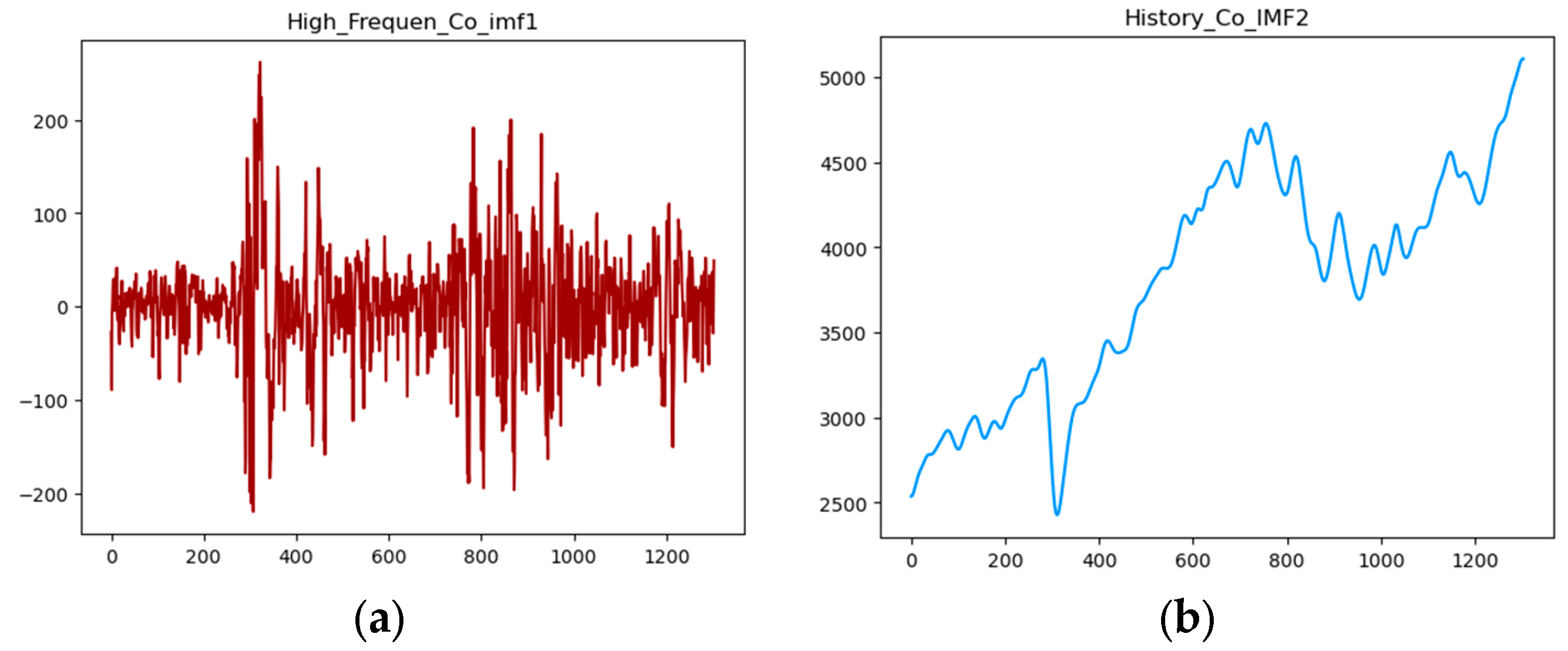
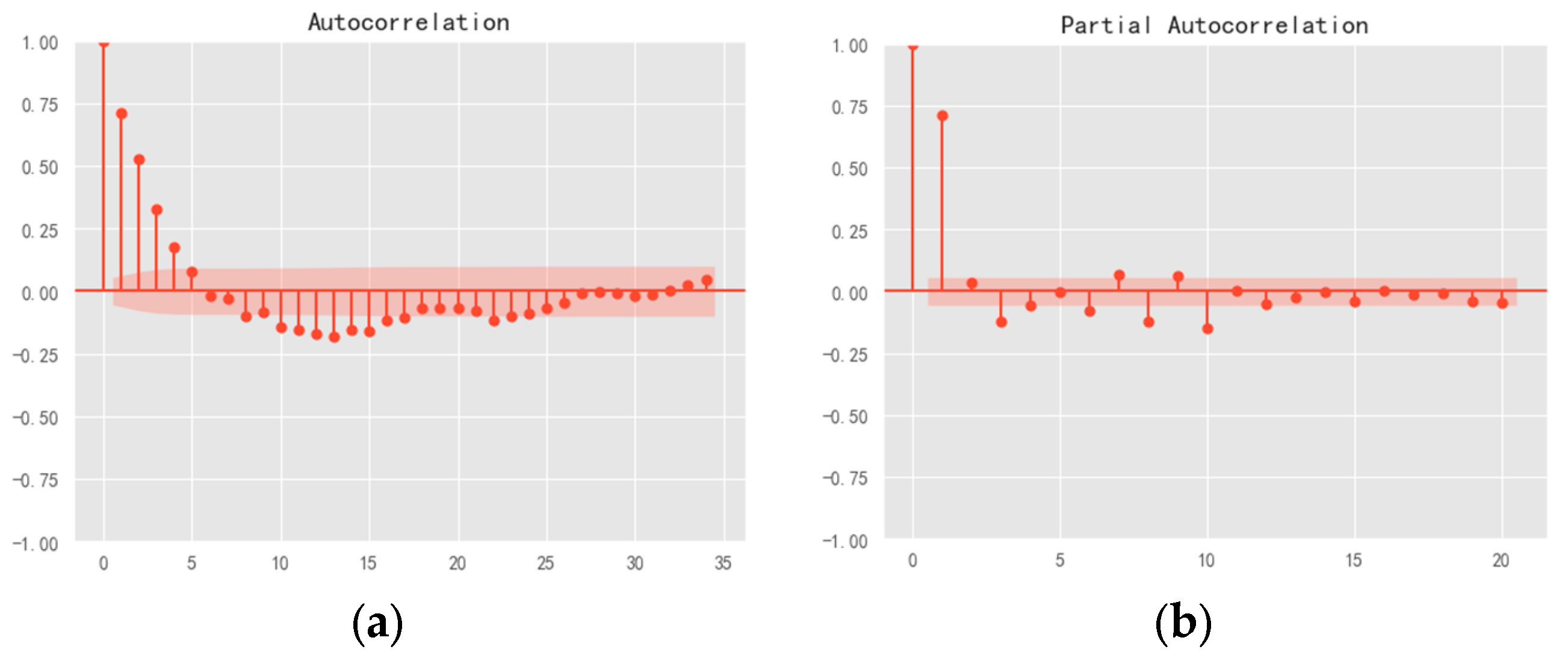
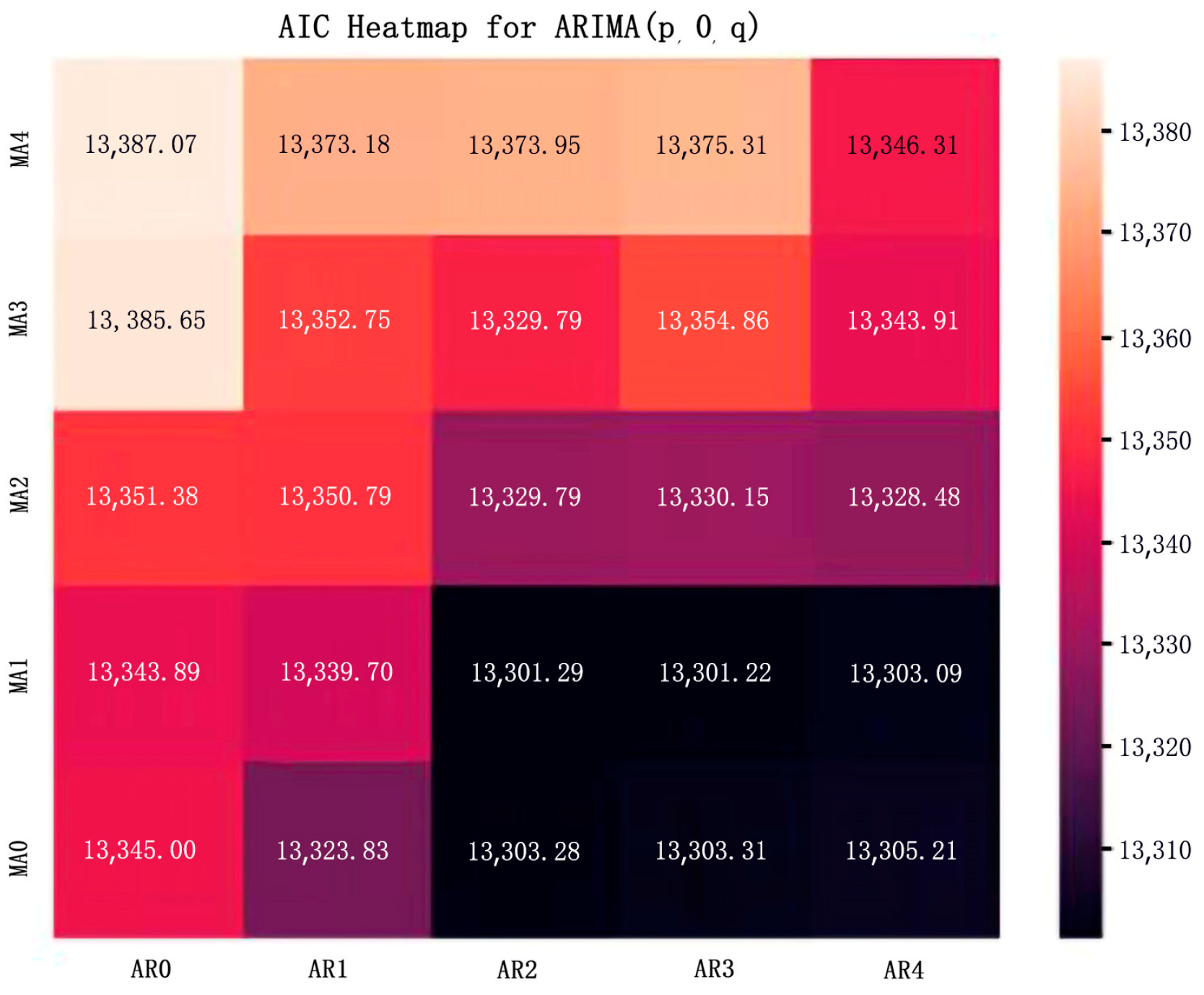


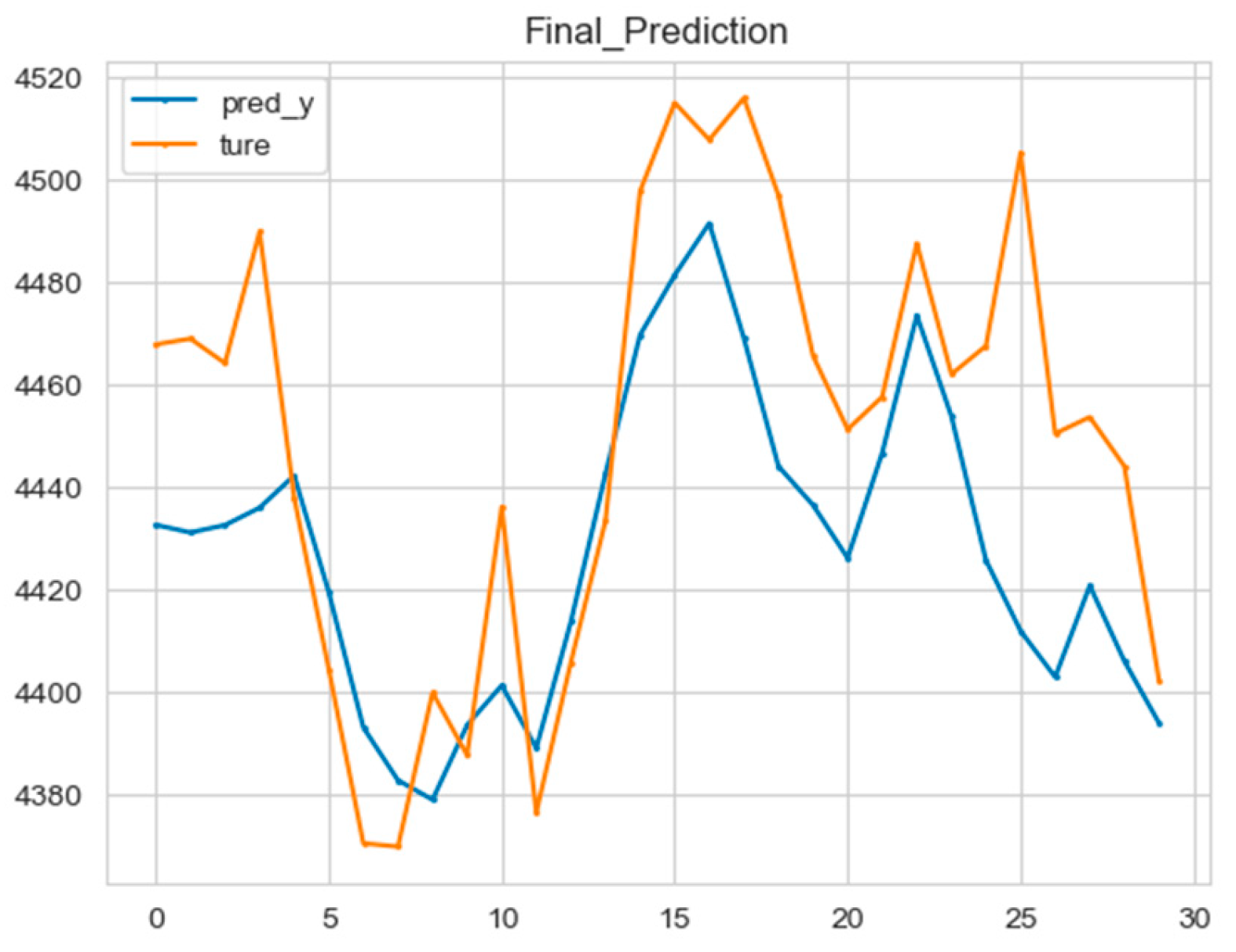
| Model | AR (p) | MA (q) | ARMA (p,q) |
|---|---|---|---|
| Autocorrelation function | Trailing, exponential attenuation or oscillation | Finite length, q-th order-truncated | Trailing, exponential attenuation or oscillation |
| Partial autocorrelation function | Trailing, exponential decay or oscillation | Trailing, exponential decay or oscillation | Trailing, exponential attenuation or oscillation |
| IMF1 | IMF2 | IMF3 | IMF4 | IMF5 | IMF6 | IMF7 | |
|---|---|---|---|---|---|---|---|
| Sample Entropy | 0.0432 | 0.0383 | 0.0354 | 0.0173 | 0.0182 | 0.0153 | 0.0188 |
| Model | RMSE | MAE | MAPE% |
|---|---|---|---|
| LSTM | 50.03 | 45.51 | 1.02% |
| CNN-LSTM | 37.89 | 32.06 | 0.72% |
| GRU | 97.01 | 82.37 | 1.85% |
| CNN-GRU | 84.34 | 72.12 | 1.62% |
| Proposed model | 33.58 | 27.72 | 0.62% |
Disclaimer/Publisher’s Note: The statements, opinions and data contained in all publications are solely those of the individual author(s) and contributor(s) and not of MDPI and/or the editor(s). MDPI and/or the editor(s) disclaim responsibility for any injury to people or property resulting from any ideas, methods, instructions or products referred to in the content. |
© 2024 by the authors. Licensee MDPI, Basel, Switzerland. This article is an open access article distributed under the terms and conditions of the Creative Commons Attribution (CC BY) license (https://creativecommons.org/licenses/by/4.0/).
Share and Cite
Dong, Z.; Zhou, Y. A Novel Hybrid Model for Financial Forecasting Based on CEEMDAN-SE and ARIMA-CNN-LSTM. Mathematics 2024, 12, 2434. https://doi.org/10.3390/math12162434
Dong Z, Zhou Y. A Novel Hybrid Model for Financial Forecasting Based on CEEMDAN-SE and ARIMA-CNN-LSTM. Mathematics. 2024; 12(16):2434. https://doi.org/10.3390/math12162434
Chicago/Turabian StyleDong, Zefan, and Yonghui Zhou. 2024. "A Novel Hybrid Model for Financial Forecasting Based on CEEMDAN-SE and ARIMA-CNN-LSTM" Mathematics 12, no. 16: 2434. https://doi.org/10.3390/math12162434
APA StyleDong, Z., & Zhou, Y. (2024). A Novel Hybrid Model for Financial Forecasting Based on CEEMDAN-SE and ARIMA-CNN-LSTM. Mathematics, 12(16), 2434. https://doi.org/10.3390/math12162434





